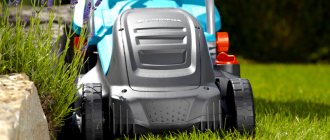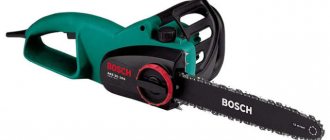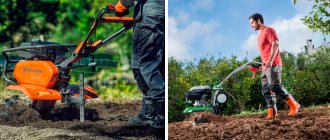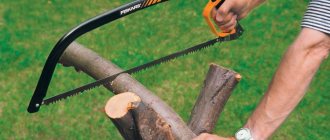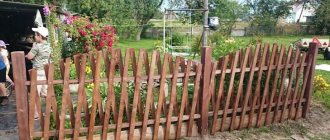Garden shears
This hand tool is necessary for working in the garden or vegetable garden. Using scissors, they shape the crowns of fruit and ornamental trees, trim berry bushes, vineyards, and cut the grass on lawns. The tool consists of cutting knives connected by hinges, two handles and a spring bracket.
High quality steel is used to make scissors. But the tool is not suitable for trimming thick branches, since plant stems may be damaged during operation. Garden shears are called a universal tool.
Try different mechanisms before purchasing
If possible, you should try out different versions of pruning shears in practice to evaluate the ease of use of each one. The now fashionable pruners with a ratcheting mechanism are not suitable for everyone: the need to squeeze the handles several times during one cut slows things down and tires you, and even the cuts turn out uneven. Therefore, it is better to try different types of pruners in advance. You can ask gardeners you know to use their tool: just cut a couple of branches, and it will become clear whether you need this pruner or not.
Ratchet pruners are inconvenient
Many people like ordinary spring pruners: for some reason, tape pruners fail faster, while those made on the principle of clothespins or pins cling to everything. Someone is used to using curved blades, one of which cuts and the other does not. Everyone likes something different, so it’s best to try out the pruning shears in person before purchasing.
Secateurs come with a regular spring, tape or with a pin
Tools for pruning bushes
When choosing a garden tool, you need to focus on the volume of work performed regularly. To trim the bushes that enclose the area, use two-handed scissors, the blades of which are long and have pointed ends. They are called manual hedge trimmers. Large plants are best trimmed with scissors whose blades have serrated or wavy edges. The knife of such a tool will hold the branch better; you don’t have to worry about it accidentally slipping out. Small shrubs can be cut well with scissors with a short blade that has straight edges.
Garden shears for bushes can also be used in cases where it is necessary to trim off excess leaves. The knives of manual brush cutters are often coated with a layer of protection against metal corrosion and the adhesion of vegetation. They are coated with zinc, Teflon or other material. However, you should be aware that when re-sharpening the knives, the coating is removed, and the hedge trimmer will quickly become unsuitable for garden work. Now they are producing garden tools whose old knives can easily be replaced with new ones.
Use of grafting scissors
Plant grafting is one of the most important areas of breeding. Such a tool is equipped with replaceable blades that allow you to make a shaped cut on both the scion and the rootstock.
Thanks to this feature, the scion and rootstock are most optimally combined along the cambium, which increases the plant’s chances of normal development.
Grass shears
This tool is an indispensable assistant when you need to improve vegetation on lawns in places inaccessible to machinery. Scissors cut it perfectly, and the entire length of the knife is involved in this process, and not just its upper part. They produce hand garden scissors of different models. There are scissors that rotate at an angle. Some models have elongated handles, which allows you to mow the lawn not in a horizontal position, but in a vertical position.
When purchasing a tool, you first need to try the garden shears on your hand and try it out in practice. If you cut the shoot with a well-adjusted and sharpened tool, then this place will be smooth, without any dents.
Electrical Products
Electric tools are used to create landscape design and care for shrubs, trees and hedges. There are differences in the following parameters:
- motor power;
- type and shape of blades;
- knife length;
- location of the switch and buttons.
The working parts are double-sided serrated blades. Thick branches can be processed with this tool, but it all depends on the distance at which the teeth are located from each other. The length of the knives is important: to create curly haircuts, short blades are chosen, while regular cutting is performed with a tool with long blades.
These scissors can serve as a manual grass clipper, as they provide the ability to adjust the position of the knives - set the blades at the desired angle. Since power tools are potentially dangerous, they are equipped with a safety system and have a protective shield between the handle and the blades.
Cordless scissors
Battery-powered garden tools are self-powered, making them widely used for gardening and gardening. Cordless garden shears are designed for cutting grass on lawns, weeds and roots in gardens and vegetable gardens. They are called lawn ones. These scissors are available for household and professional use. The equipment of different models also differs. In order not to make a mistake in choosing and purchase good garden shears, you need to carefully study the parameters of the tool:
- The frequency of movements of the cutting knife. The indicator is considered good if its figure reaches ninety blade movements per minute.
- Smooth movement. Cutting grass with a ragged character will not produce good results.
- The size of branches, the permissible diameter of which for household tools is twelve to sixteen millimeters. Professional models have different parameters.
- The size and stroke of the blades. The knives vary in length, but their range of movement is limited by the size of the branches and is rarely more than two and a half centimeters.
- Continuous operation time. It should be taken into account that one battery charge lasts for at most two hours.
- Blade edge quality. If they are made of high quality steel and have a long warranty, chances are the garden shears will last a long time.
Outline view
They have one convex cutting surface. The second part is shifted relative to it and acts as a stop. When a working operation occurs, the cutting element moves along the stem along the stop.
The tool must be taken so that the main part is oriented towards the branch. In this case, the base will not deteriorate, but the cut section will be deformed.
This option is suitable for adjusting growing branches and for grafting operations. But you need to choose those products that do not have a gap between the blades. Otherwise, you won’t be able to get a high-quality cut. The branch will collapse under pressure.
Septic tank Topas - detailed review and description of technical characteristicsPetrol mower repair: overview of faults and effective methods for solving them. Photo instructions from the pros!
- Garden composter - which one to choose? Review of the best views for a summer residence (100 photos)
Types of secateurs
- Vaccination. Such pruning shears are necessary when grafting fruit, coniferous or other plants. It is equipped with a knife that has an omega shape. It is enough to choose the scion and rootstock branches of the same thickness, the appropriate time, and a 100% merging result is guaranteed.
- Two-handed pruning shears. You can’t do without it if you need to trim thick branches, the diameter of which is more than three centimeters, or they cannot be reached with a regular tool. This pruner is called a lopper. It is equipped with long handles and complex levers, one of which is a ratchet gear. This pruner is also called a garden monster. It easily cuts thick branches with a diameter of six centimeters.
- Rod pruners are used when you need to work at a height that cannot be reached with other tools of this type. It is called a high-rise lopper. This tool has a telescopic rod, allowing the gardener to reach the very top of the tree. Tree shears can cut any branch.
- Secateurs with an anvil. Cuts dry and old branches with a diameter of three centimeters. The blades open wide. The tool is designed so that its design exerts force on the branch during cutting, and the anvil is the bottom blade.
- Bypass pruner or standard pruner. It is used when you need to trim living branches. The cutting part of the tool is represented by a movable knife and a fixed stop. This type of pruning is gentle.
One of the best models is considered to be a pruner from Fiskars (Finland). Secateurs from the German company Gardena are no less popular among gardeners. A tool from a Japanese manufacturer, APC, is also very popular.
Features of the lopper
Lopping scissors are widely used to trim branches 4-5 cm thick. Unlike other models, this tool has elongated handles.
- Pressing the handles releases the pressure exerted on the plant branch or vine.
- Due to their design features, loppers are used to trim old dry branches located inside the crown in hard-to-reach places on the tree.
- For very tall plants, you can purchase rod models of loppers, which are equipped with a special rod.
This detail provides sufficient access to the tallest plants.
Garden secateurs
This tool is the most common. He enjoys well-deserved respect among summer residents. Pruning is carried out by moving a sharp blade across the branch, which remains motionless and does not slide back and forth. Garden secateurs come in two types: with double-sided cutting of branches and one-sided. The first has two cutting blades, and the second has one cutting blade and one support blade. Both pruners leave a clean cut on the branch, which quickly heals. The blades of pruners with double-sided cutting move towards each other until the branch is cut by one of them, and the other slides along the surface from the inside. This blade has a curved shape and has a groove to drain plant juice. This type of pruning shears is well known to summer residents. It is used when pruning branches of living trees.
Secateurs with a single-sided blade are used to remove dead branches. They are not recommended to prune fruit-bearing fruit trees, since during work the branch is compressed, which does not allow the plants to heal quickly. The handles of pruning shears are different. For some instruments they rotate in different directions. It is very convenient and does not cause calluses on your hands.
Device and characteristics
The simplest pruner consists of the following elements:
- The working blade has a special geometry that creates high cutting ability. Thanks to its sharpness and hardness, a clean cut is ensured without unnecessary trauma to the plant, without splitting the fibers.
- Support blade - has a curved profile that allows you to capture the cut element of the plant and prevent it from bouncing off at the time of cutting. As a rule, such a blade does not have a sharp sharpening, or is a counter plate with a special groove for draining plant juice, which prevents the pruner from sticking.
- Handles are usually curved to match the anatomy of the hand, which increases the ease of use of the tool.
The entire structure is interconnected crosswise, similar to ordinary scissors, except that the length of the handles exceeds the length of the blades, thereby increasing the applied force due to the formed lever.
Between the handles there is also a mechanism for bringing the pruning shears to its original position, which is based on a spring.
Also between the handles you can see special buffers that limit the travel of the handles.
A folding safety bracket is mounted on one of the handles, designed to secure the blades in the closed position to avoid injury during transportation and storage.
It should be noted that the two parts of the pruning shears are connected to each other by means of a bolted connection (with a nut), which fixes the blades in the same plane.
Its offset relative to the center ensures the sliding movement of the cutting edges.
Types of springs
The mechanism for bringing the tool to its original position, also known as the mechanism for extending the handles, can be open or closed, and it can be based on one of the following types of spiral springs:
- Helical wire springs are classic springs that are usually equipped with cheap pruning shears. As a rule, they fit directly onto the buffers located between the handles.
- Tape (flat, ring) - reliable, are a strip of elastic alloy rolled into a spiral.
There are also pruners, the spring of which is a spiral wire ring of 2 - 3 turns, from which two sliding tendrils extend, resting on the handles from the inside.
Reminds me of a locking pin.
Material
The pruning shears body is made of steel and aluminum alloys.
You can also find titanium tools on sale, which are characterized by high strength and low weight, and even the blades are made of titanium.
The aluminum version, however, is noticeably cheaper, although in terms of performance characteristics it is actually not inferior.
Secateur blades are made of stainless, carbon, hardened or U8 tool steel with oxidized or Teflon coating.
The latter not only protects the blade material from corrosion, increasing service life, but also prevents debris from adhering.
The body handle is covered with plastic or vinyl.
Modern models are equipped with two-component handles, which are based on a harder material, for example, FiberComp.
The places with which the hand comes into contact are covered with soft shock-absorbing inserts, such as SoftGrip.
Dimensions and weight of secateurs
The length of pruners is usually 180 - 250 mm, and such a tool weighs from 110 to 730 g.
The maximum cutting diameter is usually 10 – 20 mm, and for some models it can reach 26 – 30 mm.
How to sharpen pruning shears?
First, the scissors are disassembled and washed. This requires warm water, soap and a cleaning device such as a toothbrush. To remove stubborn stains from plant sap or other contamination, you need to take sandpaper or metal shavings and clean the area.
You can sharpen the dirt using a grinding device. If one is not available, a file with a whetstone is used. There is no fundamental difference between sharpening a pruner and a knife.
Criterias of choice
Choosing garden pruners for your needs is not an easy task. What should you pay attention to when purchasing?
- Blade sharpness: they should be sharpened as much as possible.
- The handle material is plastic, reinforced polyamide or fiberglass with an anti-slip effect. Better - with a rubberized lining.
- Design of the handles: the hand should feel comfortable on them. Look for models with a special indentation for your fingers.
- Reliability of fastening: the bolt and nut must firmly fix the cutting blades.
- Spring: choose a belt mechanism, it is considered more reliable than the usual wire spiral.
- Contact of blades: when connecting, they should not form a gap that will become a garbage collector and injure the plants.
- Check: Be sure to try the tool in the store. Cut a piece of paper with it. Evaluate the ease of use and cut quality. Feel free to ask questions to the consultant.
- Design: poisonous orange, deep purple, sunny yellow and bright red details - not for beauty, but to make the tool easier to find in the grass.
Pay special attention to the material of the blades, since the main load will fall on them. Well proven:
- 65X13 - steel for making knives, is corrosion resistant, often used in the production of domestic models;
- SK-5 - high-carbon tool steel, holds an edge well, used in Chinese and Japanese products;
- 440A - durable anti-corrosion steel;
- AUS-6 - an analogue of 440A, produced in Japan and improved (has much greater wear resistance);
- titanium is a light and durable alloy, the most rust-resistant of all the above materials.
When purchasing, look more carefully at those areas of garden pruning shears where defects most often occur:
- poor factory sharpening of blades;
- nicks and roughness on the cutting plates;
- loose bolt;
- a weak, practically non-cushioning spring, or vice versa - so tight that the handles cannot be compressed;
- worn spring rings;
- the gap between the blades when they come together;
- when cutting, the paper tears, leaving uneven edges;
- damaged integrity of the rubberized linings on the handles (scratches, holes, torn edges);
- loose fit of the lining on the handle (the rubber moves and creates a sliding effect, which can result in injury);
- non-compliance with the equipment stated in the manufacturer’s instructions.


